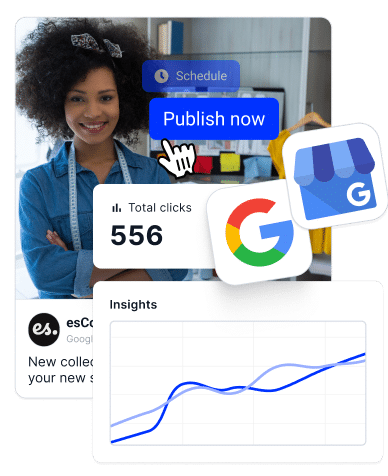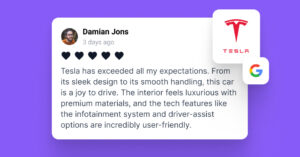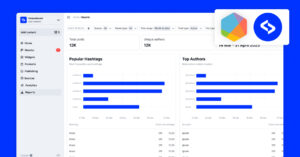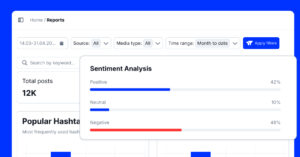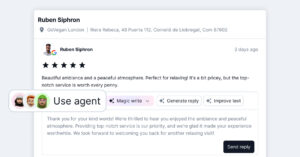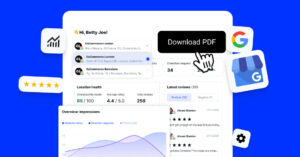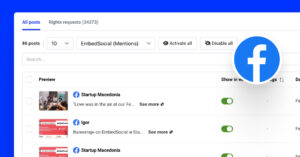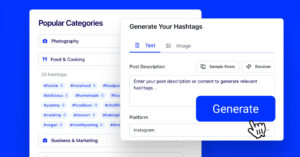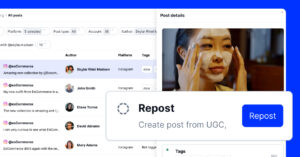Making money on social media as a UGC creator is a dream that can easily become reality!
You’d be selling products and services online, striking brand partnerships, earning a commission as an affiliate marketer, participating in influencer marketing, and monetizing your user-generated content as part of this job, and that’s only the start!
So are you interested in learning how to become a UGC creator? Remember, most big brands are using social listening to aggregate the content you are creating for them.
Its a great place to start building your influencer profile and getting boosted by brands by sharing their UGC.
What is UGC?
Before explaining what UGC creator is, let’s cover the basics of what does UGC stand for:
UGC stands for User-Generated Content, a term that refers to a wide range of creative outputs created by everyday individuals rather than professionals.
User-generated content is content related to your brand but created by your real customers instead of employees.
UGC definition
If you are wondering why user-generated content instead of content created the usual way – UGC increases conversion by 10% in an online buying process.
This type of content includes text, images, audio, and video and can be found on numerous digital platforms.
The UGC meaning has become increasingly popular as it allows people to share their unique perspectives and talents with a global audience, often forming online communities and connections.
Additionally, the rise in UGC has revolutionized user-generated content creation, making it widely accessible and inclusive for people across various demographics.
What is a UGC creator?
Now, it’s only fair we move on to covering what a user-generated content creator is:
UGC creator definition
UGC creators vs. content creators
In short, UGC creators are everyday individuals who create content to express their creativity and ideas, while content creators are professionals or semi-professionals who produce content to inform, entertain, or educate.
UGC creators primarily focus on building communities and connections, whereas content creators often aim to influence culture or promote brands. Here is a table with the main differences:
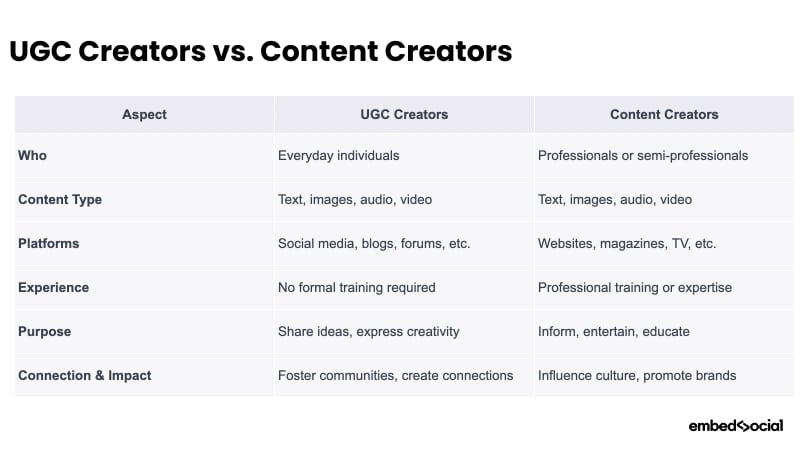
UGC creators vs. influencers
Often, these creators are confused with influencers who post on their social channels about certain products. However, the main difference here is where this influencer-generated content is posted.
Micro-influencers are getting paid to promote products to their target audience/ their community, influencing their purchasing decisions to buy that product. Additionally, brands are paying these influencers for their products to reach a broader audience (the one the influencer has).
UGC creators could create similar content even for that same brand, but the content will be posted on the brand’s channels. In this case, brands are not looking into raising awareness and achieving a higher reach for their products/services; instead, they are looking for an authentic feel for the content.
For example, we can take this reel posted on Sephora’s Instagram profile, where a fashion influencer explains her hair routine with versatile products and hair styling tools:
Why do brands love UGC creators?
As we’ve already mentioned – user-generated content increases conversions, and here are some UGC stats that confirm this:
- 75% of marketers claim that UGC makes the brand more authentic;
- 31% of consumers say that ads containing authentic UGC content are more memorable than branded content ads;
- Consumers spend 5,4 hours a day with user-generated content;
- Marketers don’t need to have a big marketing budget for UGC creation.
As you can tell, brands love user-generated content because it hugely impacts their marketing strategy – but why is that?
Convince brands about the power of UGC – copy paste this and send to them:
UGC > Social Proof > Increase in sales
User-generated content is so impactful simply because it provides people with social proof.
Social proof, on the other hand, works because people trust people and not brands directly. It’s as simple as when you get a certain recommendation from a friend about a certain product, and you’re instantly hooked and ready to try it out.
Content created by UG creators is more engaging, trustworthy, and with higher credibility.
Other than this, content created by UG creators will help you:
- Save valuable time and money and avoid the current weaknesses of content creation that can be frequently expensive and time-consuming to create.
- Build a loyal fanbase by showing that your brand is open to communicating with your audience, and this type of content will help you create a stronger bond with your audience.
- Create authentic content like videos with real peoples’ experiences that are preferred by social media algorithms, meaning this content will get a higher reach (get through to more social media accounts and profiles)
Now that we’ve answered the “what” and the “why,” – it’s only fair we move on to the “how” – how to become a UGC creator.
How can smaller creators break through with advertisers?
We are sharing an insight from Adam Mosser, the Head of Instagram himself, who shares some of the best advice on this topic:
Q: What are some sort of metrics or talking points that smaller creators could use to convince advertisers?
A: I think it’s probably about being more clear about who your audience is and why that audience is disproportionately valuable to that advertiser.
So, you know, let’s use, I don’t love the example of supplements because there’s so many shady actors in that world, but it’s an easier example.
If you only have a few thousand followers, but they’re really passionate, and they’re all about biohacking and health stuff, then they are way more valuable to a thorn supplement advertiser than the average person.
And so you shouldn’t just care as the advertiser about the number.
You should care about how much, how likely, in this case, those followers will wanna by the product. It is about understanding the niche and why that niche is disproportionately valuable to that advertiser.
Adam Mosseri
Knowing all the above, continue reading to get the actual steps on how to become a UGC creator.
How to become a UGC creator? (8 simple steps)
Becoming a UGC Creator is fairly simple, and you don’t even need a huge follower count or high engagement levels.
Why? Simply because you’re not looking to influence your followers but the audience of the brand you’re creating for (the content will be published on their profile). Moreover, you won’t need special equipment to make this content.
So, what exactly do you need? Here are the exact steps if you’re just starting:
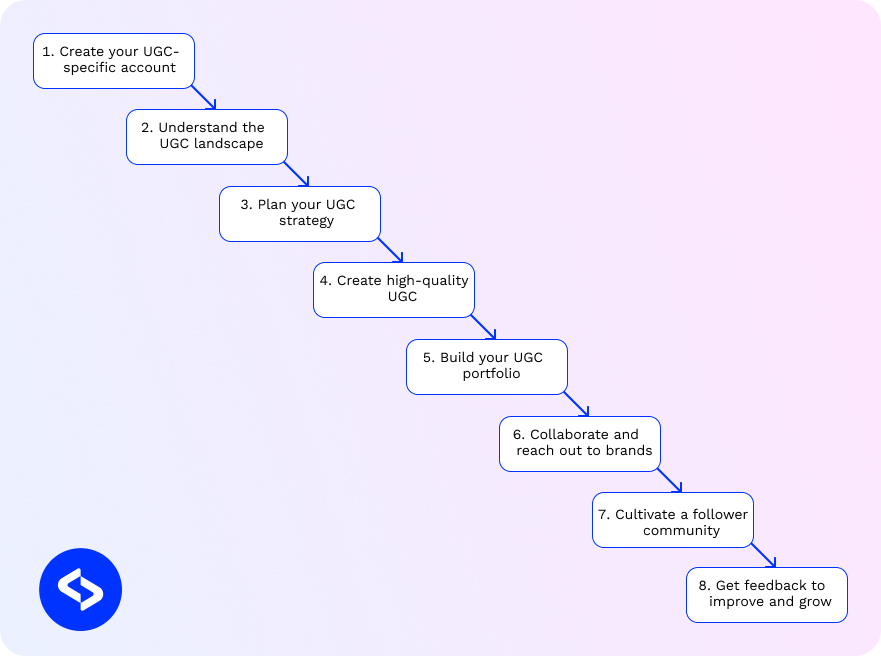
1. Create your UGC-specific account
Create an account on the platform(s) that aligns with your content goals. Choose a username that reflects your brand or niche, and complete your profile with a compelling bio and relevant details.
Creating a different account will allow you to separate your personal from your “brand” account for privacy reasons. Additionally, creating an account with UGC usage in the description and/or name will help brands discover you faster and easier.
Once you create your account, you can start following other creators, sharing tips, knowledge, and experience about the creator economy, how to make contacts, and how to get your first earnings as a UGC content creator.
Don’t be scared to reach out to other creators, and engage with the UGC creator community – you never know with who you might start collaborating.
Skills you need to become a creator:
- Video and photo creation and editing skills
- Copywriting for writing cool captions and scripts for creating UGC videos
- Live communication
- Research Skills are always a plus
- Basic marketing knowledge (understanding how sales funnels work + e-mail marketing + how social media channels and algorithms work)
2. Understand the UGC landscape
Now that you have your account, it’s time to start thinking about what industry you want to work in.
Before diving into UGC creation, familiarize yourself with the industry and platforms you wish to engage with. Research popular UGC jobs and UGC trends, target audience preferences, and the specific platform’s guidelines.
Once you write down your interests, go a step further and think about brands you would like to collaborate with.
Now that you have your potential brand list, it’s time for some research, and after that, you can apply to be a UGC creator there.
Here is a list of niches you can consider:
Cooking / Recipes
Do you have a cooking talent? You can consider creating your profile around a specific cooking niche, like vegan, food for kids, etc. The key here is to choose a very narrow topic that you are good at but is not very competitive.
Fitness / Wellness
Of course, this is a very broad industry, but what about fitness for mums, fitness in the morning, and 10-minute fitness, try to research and see if any of the fitness alternatives are worth considering.
Skincare
Another super popular and demanded sector, and it might be perfect for you if you are on a certain skincare path, have a certain skincare issue, and you’re learning to cope with it with the right products/treatments/lifestyle, and even if you don’t have a skin issue – the industry is so large there’s space for every skincare enthusiast.
Fashion
Passionate about dressing up? Do showcase your daily combinations, what you would wear on certain occasions, your favorite shopping hauls, seasonal wear, and must-haves for every season, and share comments on famous people’s combinations – experiment with content and find that thing that works for you and land those collaborations and paid content creations!
Books
Regardless of how strange it might look – if that’s your interest, yes! There’s even space for such niche communities about people reading certain types of books, writing and sharing reviews, and sharing that unique book aesthetics (with underlined pages, side notes, and drawings on pages).
Productivity / Work Motivation
Maybe you’re good at explaining to others how to excel in their career, be more productive, structure their day, prioritize their tasks, etc. Maybe this is something you’ve been working on yourself for years – and now it’s the absolute best time to literally make a living out of it (out of everything you’ve learned in your spare time).
3. Plan your UGC strategy
Define your content objectives, themes, and posting frequency. Consider the interests of your target audience and craft content that resonates with them.
Planning ahead ensures consistency and a steady stream of engaging UGC.
4. Create high-quality content
Now that you have your main interests written down – you need to think about the type of content you want to focus on.
Focus on producing unique and high-quality content that captivates your audience. Use a variety of formats, such as photos, videos, written posts, or digital documents, to diversify your content and cater to different preferences.
Are you more interested in creating photos, personal short-form videos, or short-form reels for both Instagram and TikTok UGC videos? Think about this: take some courses to educate yourself if needed, and start creating.
5. Build your UGC portfolio
Compile your best UGC pieces into a compelling portfolio. Showcase your creativity, skills, and unique perspective. This portfolio will serve as a compelling representation of your capabilities when collaborating with brands or seeking opportunities.
Creating a portfolio will help you showcase who you are, what you do – your previous work, and how you could help brands with content.
Here are a few resources to help you create your portfolio:
- how to create your portfolio in Canva
- what to put in your UGC portfolio
- an example of a portfolio,
- some common mistakes to avoid.
If you want to find more tips about your portfolio, make sure you follow the hashtag #ugcporfolio.
6. Collaborate and reach out to brands
Establish connections with brands and explore partnership opportunities. Leverage your UGC portfolio to demonstrate your value and expertise. Initiate conversations, engage with brand campaigns, and build mutually beneficial relationships.
If you place UGC in your description and user name, brands will eventually reach out to you for collaborations, but surely that won’t happen at the beginning since the competition is so high.
If you’re scared, here’s how to start with brand outreach with these useful TikToks:
- Write an e-mail outreach
- how to avoid your e-mails landing in the spam
- some additional tips.
7. Cultivate a follower community
As a UGC (User Generated Content) creator, your number of followers is crucial for your online success.
Building a dedicated and engaged audience ensures that your content reaches the right people, which can lead to exciting collaborations with brands and businesses.
Moreover, a strong follower base enhances your credibility as a marketer, allowing you to effectively promote products and services on various social media platforms.
To begin building a community, inspire with some examples of successful UGC creator communities:
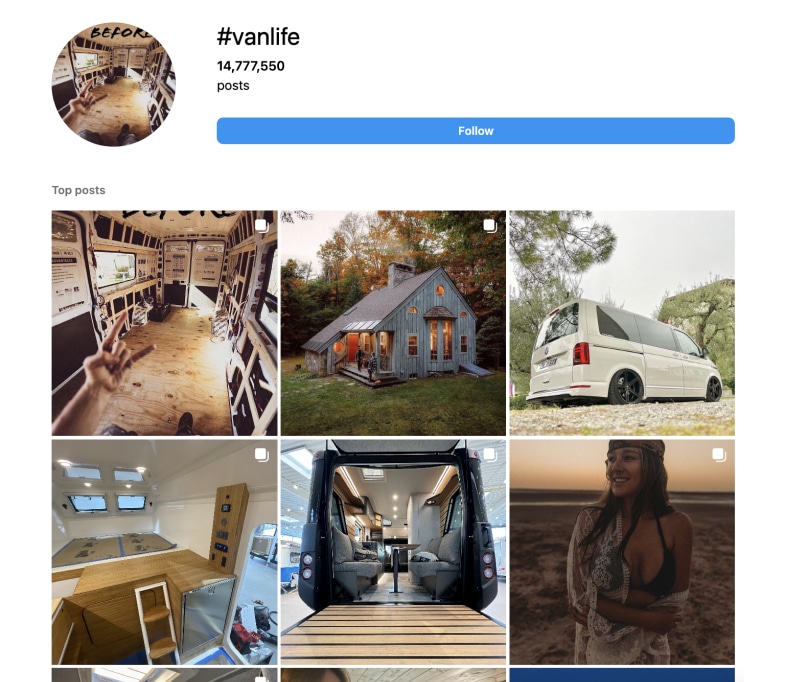
- The #VanLife community: UGC creators focusing on living and traveling in vans have built a thriving community on platforms like Instagram and YouTube. This community shares tips, experiences, and stories about life on the road, fostering a sense of camaraderie among its members.
- Bookstagram: UGC creators in the literary world have fostered a vibrant community on Instagram, where they share book reviews, reading recommendations, and creative photos of their favorite reads. Bookstagrammers often participate in reading challenges, buddy reads, and bookish discussions, connecting with like-minded individuals who share their passion for literature.
- Studyblr: This community, primarily based on Tumblr, brings together students and learners from various academic backgrounds. UGC creators in this niche share study tips, resources, and motivation, fostering a supportive environment where members can exchange ideas and help each other succeed academically.
8. Get feedback to improve and grow
Receiving and implementing feedback is a vital step in the journey of becoming a successful UGC creator. Feedback from your audience helps improve your content and strengthens your relationship with your community.
By actively seeking feedback and using it to refine your work, you can establish your career and yourself as a creator who values your audience’s opinions and is dedicated to delivering the best content possible.
UGC creators on social media platforms
Let’s check out a few good examples of UGC creator profiles on social media:
Examples of UGC creators on Instagram
Before diving into examples of successful UGC creators on Instagram, let’s explore how you can embark on this creative journey yourself.
Here’s a guide on becoming a UGC creator on Instagram and finding other creators there, unlocking the potential to turn your social media presence into a source of income and influence through authentic and engaging content.
In the search bar on Instagram, you can type in the hashtag UGC (#UGC) and go into the “Accounts” tab. Here, you will find different accounts/people who placed UGC in their profile description, meaning they offer such services.
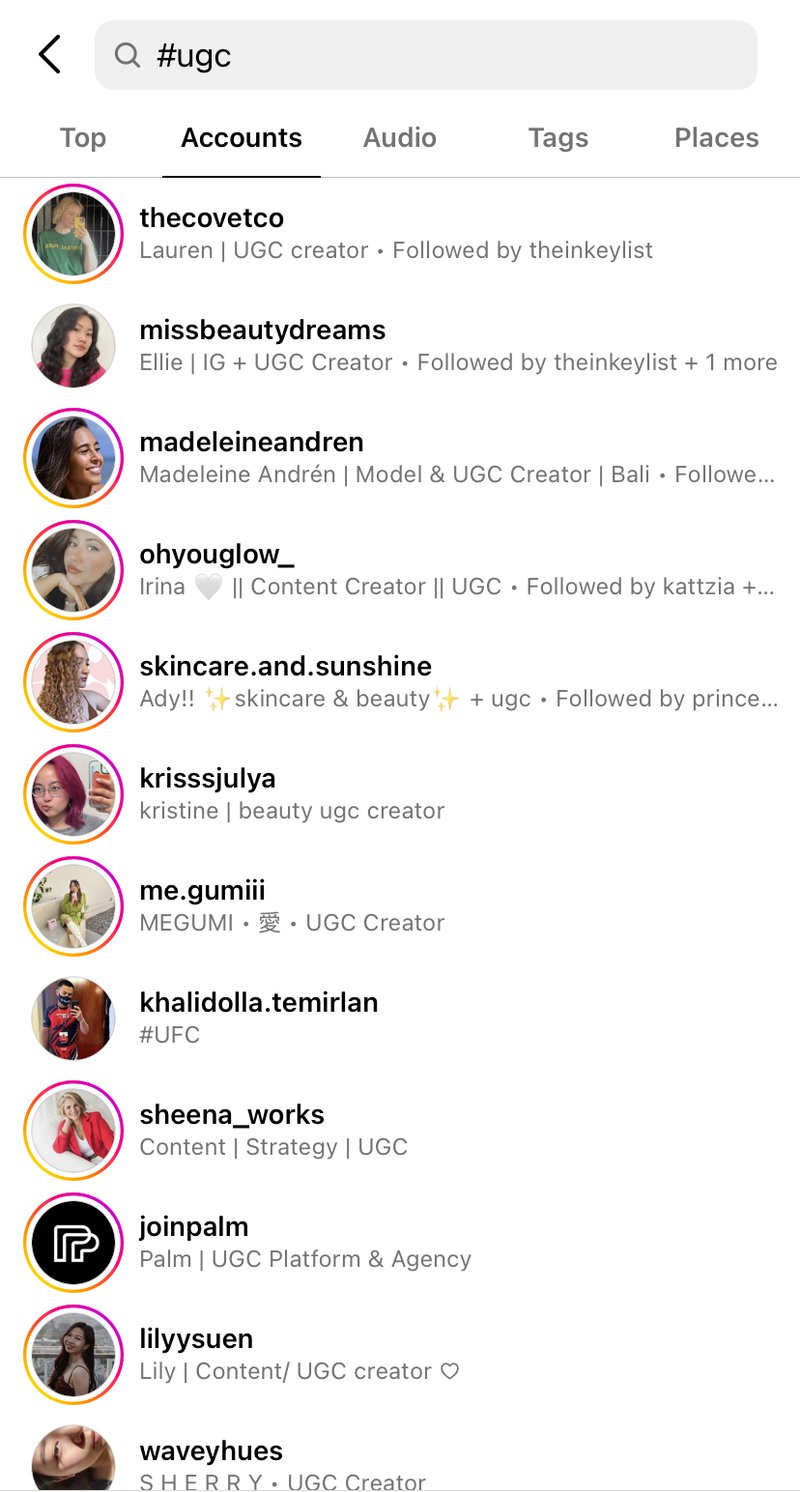
Now, let’s dive into some of these profiles and see some details.
1. Lauren – The CovetCo
As Lauren’s description says – she’s a self-proclaimed UGC creator who can create content around beauty, wellness, and skincare. Additionally, she shares her location, e-mail address, and link to a website.
Another important thing, in her highlights, we can spotlight a “previous clients” highlight, which serves as her portfolio and showcases brands she previously worked with. Lastly, if you want to take your research next level, you can go into the “tagged” part of her profile, where you can see some published projects (UGC content) for versatile brands.
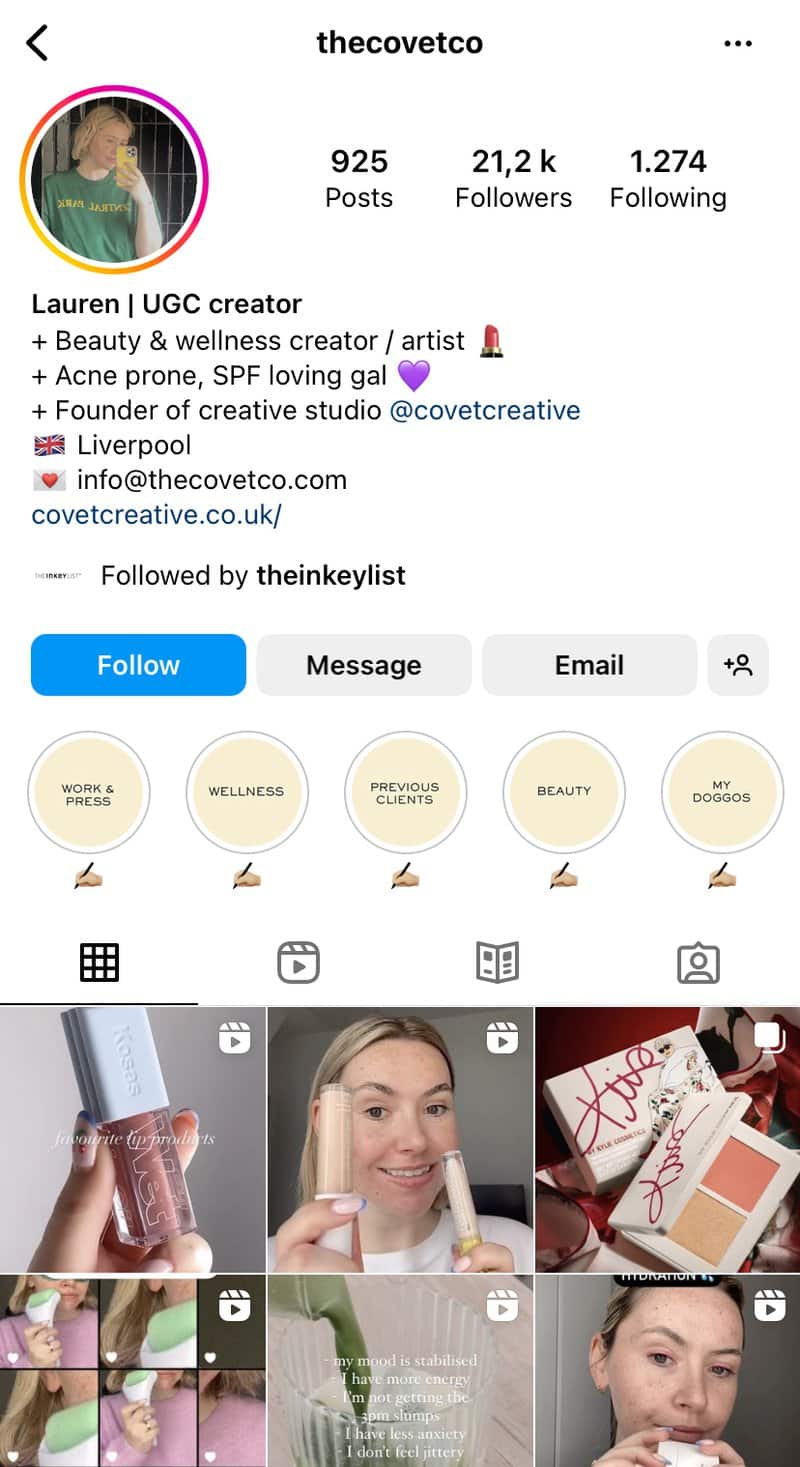
2. Esra – EsraBrekelmans
The main difference between the first and second Instagram profiles is their niche/industry, Lauren was a skincare creator, and Esra is a fashion creator.
Besides this, both of them have a similar bio, description, and information (e-mail address and a link to relevant website).
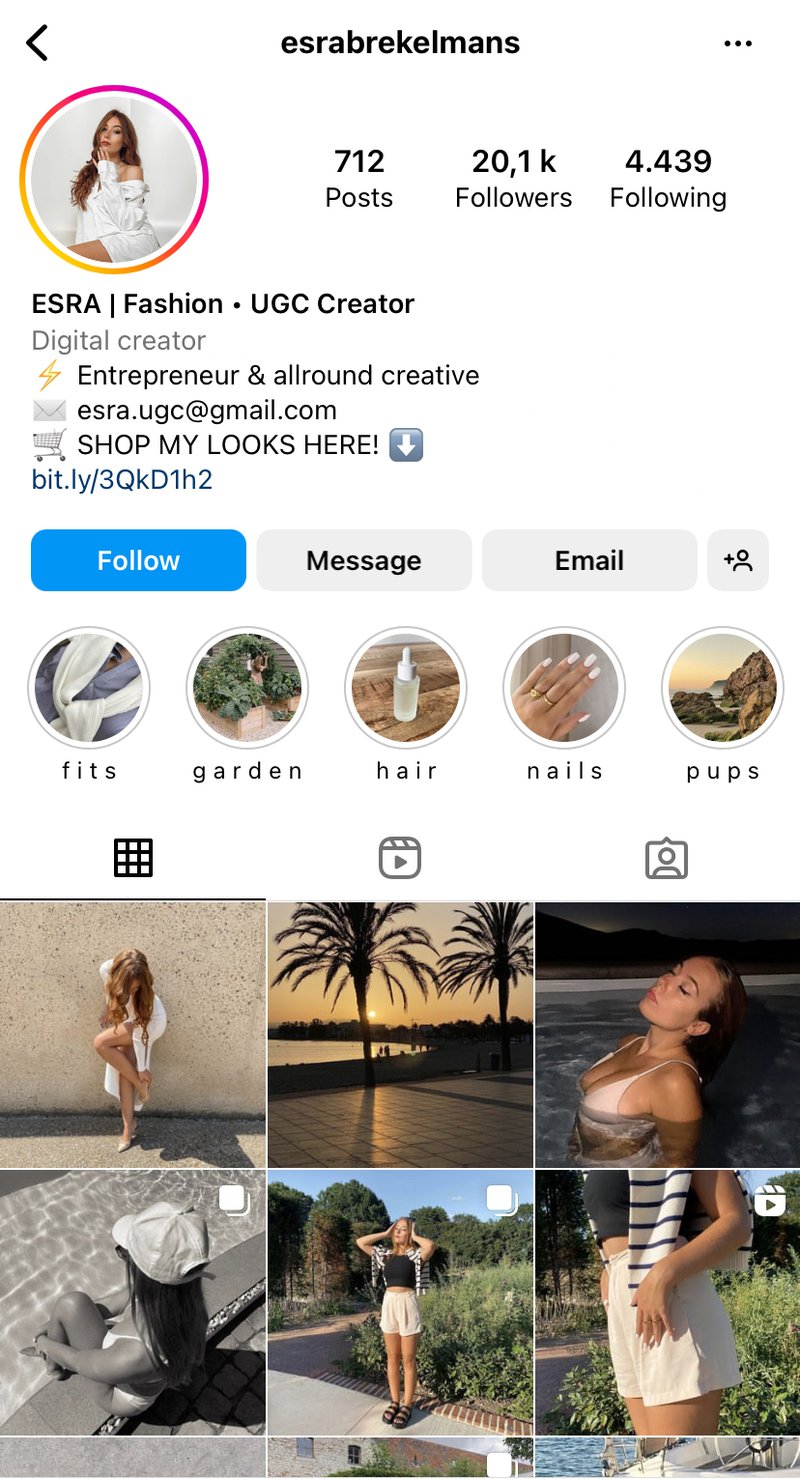
3. Kim – Kim_bulan4
Lastly, I am a food/travel vlogger and creator with information similar to the previous accounts. A statement of what he does, promoting his other TikTok profile, sharing that he’s open to collaborations, and a link to his latest vlog.
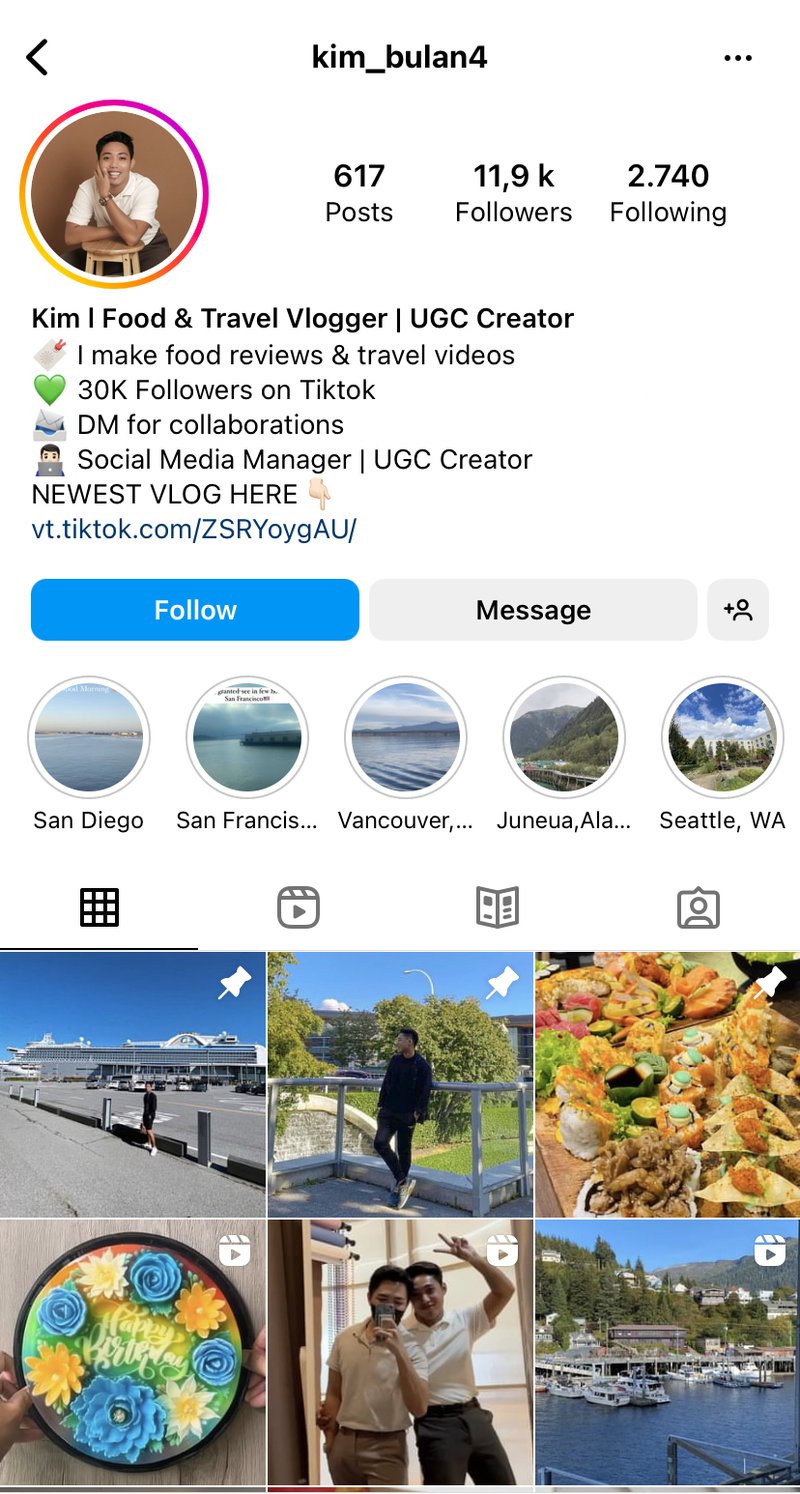
Examples of UGC creators on TikTok
Now that we’ve covered Instagram, we’re moving on to showing you how to become an ugc creator on TikTok.
If you’re wondering why Tiktok? To put things in perspective – we’re placing some screenshots with much-needed data.
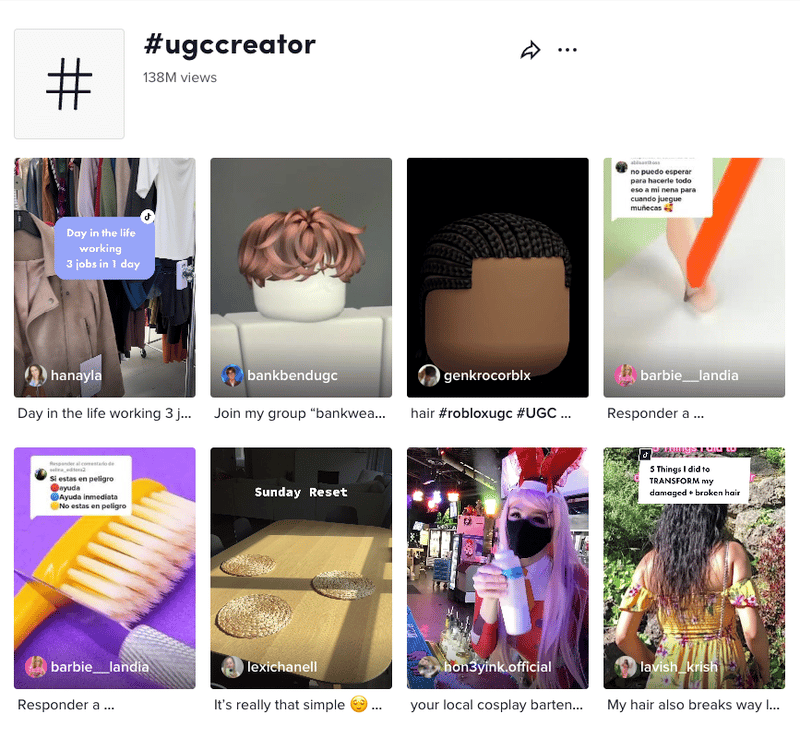
1. Ang Wells – UGCang
With almost a million likes, Ang Well – UGCang Tiktok’s profile is available for UGC brand partnerships and is here to raise awareness about this type of content and educate fellow creators.
In her description, she’s transparent about collaborations and sharing a single link to her offers, such as the UGC Creator Course, an Inquiry submission for brands, and personalized consultation.
She teaches other people how to become UGC creators, and she shared her opinion on the topic:
Even if you buy the best UGC course out there, if you do not hone in on your skills and practice, you will not see results. And basically, that course will be useless. That right there is the truth. Brands want to work with good creators, so you have to become a good creator, and that takes time to build that skill.
Anyone can do it, but everyone’s journey will be different.
But no matter what, if you have someone teaching you, you’re going to get there quicker than if you’re figuring it out all on your own using trial and error.
That is not to say you need a course to succeed. You don’t need to buy anything. It just depends on how you want to spend your time.
Ang Wells, UGC creator and mentor.
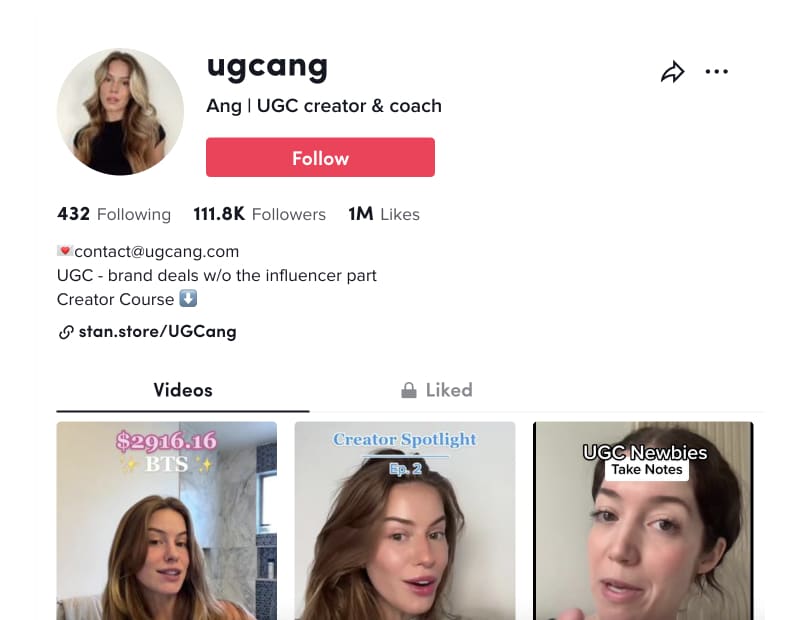
2. Diaryofaugccreator
Our second example is Diaryofaugccreator, a UGC creator from Germany who has more than a million likes and almost 200k followers.
Besides her location, she also has a short list of her interests (lifestyle, digital diary, and cats), an e-mail address for contact, and a link to her page.
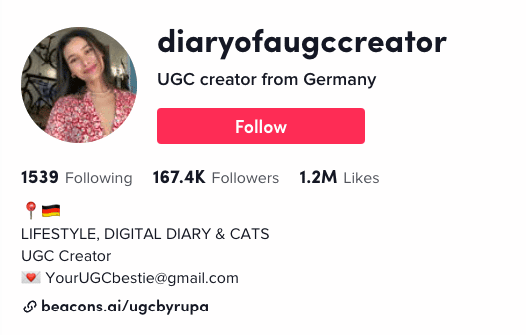
3. Sociallydani
Our third and last TikTok example is Sociallydani, both content creator and coach. With almost 30k followers and 250k likes – here’s what her profile description looks like.
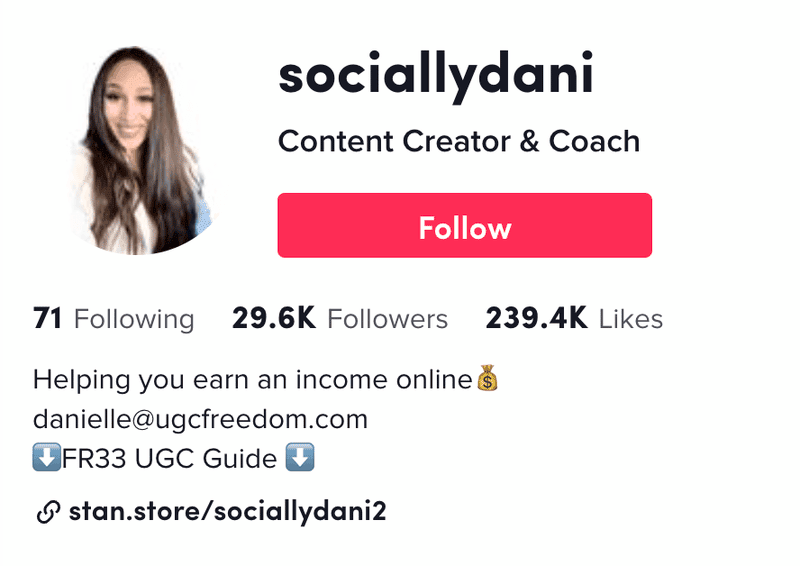
In her description – she has her unique selling proposition, a mail you can reach out to, and a link to a great UGC guide.
4. Ashley Yi
Ashley Yi, also known as @ashyizzle on TikTok and @ashyi on Instagram, is quickly becoming one of the most entertaining and relatable creators on social media platforms. With over 5.6 million followers on TikTok 400K on Instagram, Ashley’s content features everything from hilarious skits to heartfelt moments with her friends and family.
One thing that truly sets her apart from the rest is her ability to be transparent about her own struggles and insecurities, and many times in a hilarious format. Whether she’s sharing a funny moment or discussing a serious topic, she always manages to make her viewers feel like they’re right there with her. So if you’re looking for a breath of fresh air be sure to check here out.
Here is an example of recent UGC content she created for @baskinrobbins and their new flavor of the month:
You can read below the script of the UGC video:
Chicken and waffles, but make it ice cream.
Chicken and waffles. Ice cream is Baskin Robbins newest flavor of the month. So you know, I had to run over and get my brunch on ice cream style. Oh, look at that swirl. Oh, this tastes exactly like a buttermilk waffle. By the way, there is no chicken in this ice cream.
Wow.
The crispy chicken and waffle bites is a little salty, and the bourbon Maple syrup is sweet, so it’s like a perfect match. Also, I just found out there’s a secret 31 in the Baskin Robbins logo, which represents Baskin Robbins iconic 31 flavors. Basically, you can have a new flavor of ice cream every single day of the month.
Chicken and waffles ice cream.
It’s so good.
Ashley Yi, TikTok UGC video example
How do brands utilize user-generated content?
Moving on from the content creator’s profile to versatile brands, we will look at examples of how they utilized UGC in their content strategy.
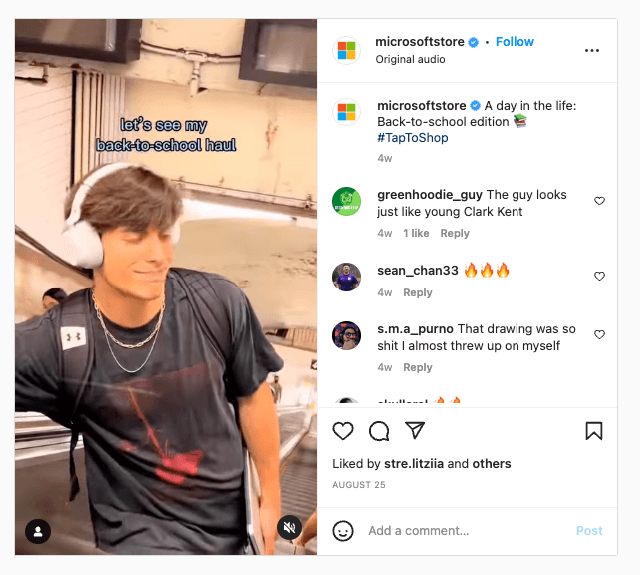
Related:
Check out even more user-generated content campaigns created by brands:
20 Inspiring User-Generated Content Examples And Why They Work
Tool to generate user-generated content
EmbedSocial is a complete user-generated platform that helps creators and brands aggregate UGC across all major social media networks, like Instagram, Facebook, TikTok, YouTube, Twitter, Vimeo, and Google Business profiles. It is one of the best UGC platforms for creators because it has direct integrations with the major social media networks that enable users to generate content automatically in just a few clicks.
The content that can be generated includes reviews from Facebook and Google, Instagram stories, Instagram feeds from mentions, hashtags, or accounts; Twitter feeds from mentions and accounts, YouTube video channels and playlist feeds, and similar.
UGC creators can use UGC platforms like EmbedSocial to help brands aggregate all the content that mentions their brand on social media or post by using a specific hashtag that can be relevant to the brand’s sector.
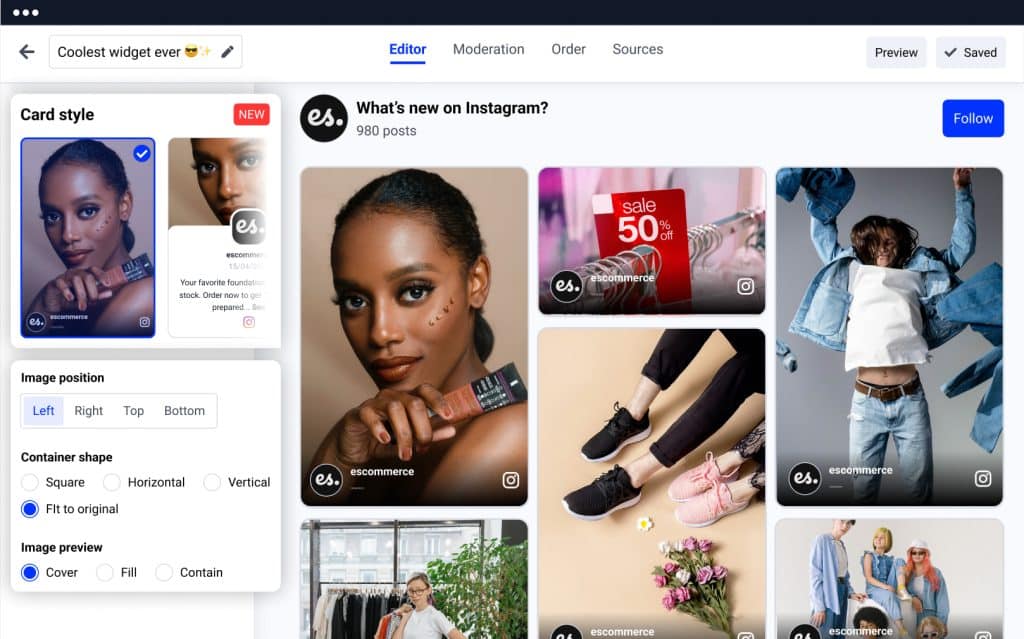
To summarize, here is what UGC creators, together with brands, can do with a platform like EmbedSocial.
- Discover similar content that other creators do for the brand – at scale. Just add a hashtag the brand uses and see what type of content can be generated.
- Provide the brand with a UGC widget for their website with the content you and other people create for their specific hashtag, or if you get permission to access their account, you will also be able to fetch the Instagram, and Twitter mentions and help them create widgets with the content posted by the people.
- You can also help the brand create a competition where people will post photos with a specific hashtag to win prizes. This is a great way to increase engagement and get more content for the brand.
- Last but not least, you can use EmbedSocial’s platform to monitor the performance of the content on the brands’ websites by also adding an additional layer of purchase by tagging the UGC content with shippable links.
Tool to send automated social media newsletters
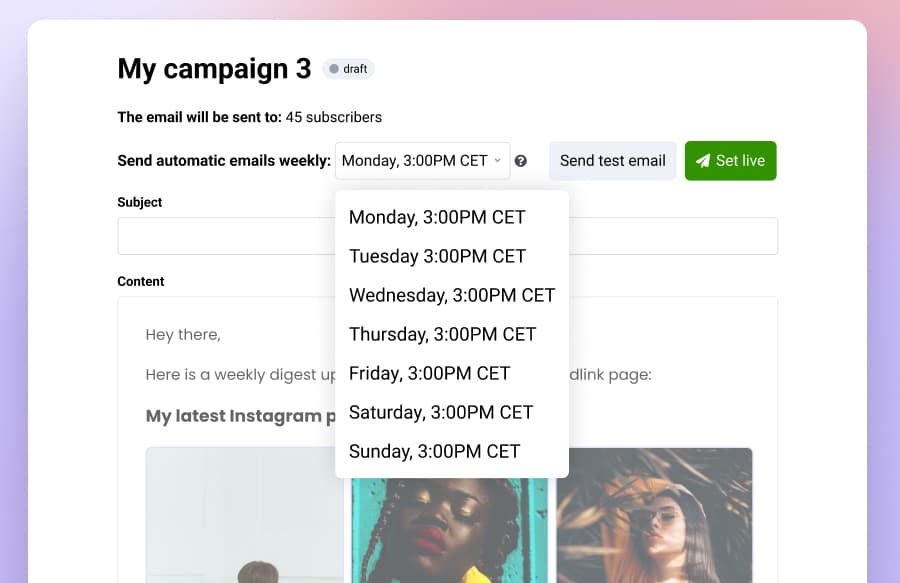
Feedlink has a built-in tool to help you grow a subscriber list and engage them via a digest with your latest Instagram and TikTok posts. It is one kind of social media newsletter tool that will give you a powerful benefit against other creators in your specific niche. You can start a free trial and connect your TikTok and Instagram profile to use it.
The newsletter works automatically, and once you activate it, it will automatically start sending every week to your subscribers, including images and videos from your profiles with the added links from your Link in bio page.
What makes a good UGC creator? Ideas to start creating UGC content
Brands love UGC creators, and user-generated content is already dominating their social media feeds. Here are a few ideas you can get to start creating UGC for your favorite brand and get noticed:
- Find out what kind of content the brand usually posts and try to recreate it.
- Start a conversation with their marketing team or directly with the brand on social media platforms such as Twitter or Instagram.
- Engage with the brand’s target audience and get to know what they like.
- Look for opportunities to attend events related to the brand.
- Take advantage of user-generated content platforms such as EmbedSocial.
- Try to be creative and develop your own post ideas for Instagram or other social media platforms that the brand may like!
- And most importantly, you really like and actually use the brand, so you can create an organic UGC that is highly authentic.
FYI: Feedlink Link in BIo tool helps small business owners and UGC creators consolidate all their links in one platform and save tons of time and money on building link-in-bio pages and publishing blogs, newsletters, and social media posts.
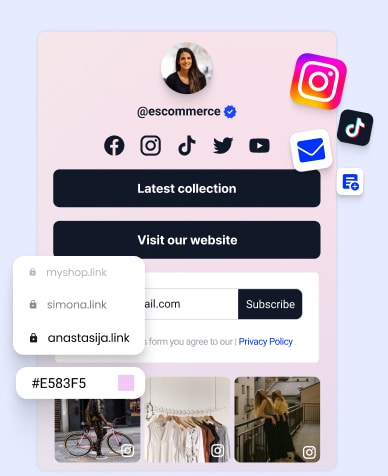
Convert followers to customers with the best link in bio tool on the planet.
Consolidate tools and cut costs with a free blog, newsletter, and social media publishing. Plus 1 year free link domain.
Key takeaways
We hope that in this UGC creator blog post, many entrepreneurs or marketers can leverage social media platforms to build their business and UGC marketing strategies as UGC creators.
Success hinges on authenticity, consistency, and the ability to resonate with your audience. With dedication, the journey from content creation to brand collaboration can be both fulfilling and lucrative.
FAQs by UGC content creators
What does UGC stand for?
UGC stands for User-Generated Content, a term that refers to a wide range of creative outputs created by everyday individuals rather than professionals. This type of content includes text, images, audio, and video and can be found on numerous digital platforms.
UGC has become increasingly popular as it allows people to share their unique perspectives and talents with a global audience, often leading to the formation of online communities and connections.
The growth of UGC has redefined content creation, making it more accessible and inclusive for people from all backgrounds.
Is becoming a UGC creator worth it?
Yes, becoming a content creator can be a great way to earn extra money or even make it your full-time job. Content creators often have more control over the content they create and how they monetize it than if they were working for someone else. With content creation, you also get the chance to build your own brand and engage with others.
How many followers do I need to get paid as a UGC creator?
No specific follower count is required to start earning as a UGC creator. However, having a few thousand engaged followers typically attracts brand partnerships and monetization opportunities. Focus on building an authentic audience and providing value to attract brands and generate income.
How much money do content creators make?
Understanding the earning potential on Instagram is crucial for those aspiring to become influencers and content creators. The amount content creators can make is varied and depends on the type of content they create, its success, and the effort they put into monetizing it.
Some content creators can earn full-time from their content, while others may only make a few hundred dollars per month.
For those looking to understand the correlation with the niche and its impact on the number of followers in terms of making money, our comprehensive guide, ‘How Much Money Do Instagram Influencers Make?’, offers in-depth insights and analysis.
Can I be a content creator with no experience?
Yes, content creation is accessible to anyone with access to the internet and a creative idea. Usually, brands look for real users or customers willing to start creating UGC for them.
You don’t need to have a huge following, but it’s important to research your area of interest, practice content creation skills, and be willing to invest in yourself and your content. Many content creators start out by creating content for free or low-cost services before eventually moving up to paid opportunities.
How do I create a UGC portfolio?
Create a UGC portfolio by selecting your best content across various platforms and organizing it in a visually appealing format. Consider using a personal website or an online portfolio platform to showcase your work, highlighting your unique style, creativity, and the impact of your content on your audience.
What kind of UGC jobs do content creators do?
Content creators can create content in various fields, including animation, photography, videography, short-form video, podcasting, writing, editing, and more. Most importantly, this is content created organically; it is original content aimed at engaging the brand’s target audience. They may also create content for different platforms, websites, and blogs.
How do I find UGC opportunities?
To find UGC opportunities, engage with your niche community, join relevant social media groups, and sign up for influencer marketing platforms. Additionally, reach out to brands directly by pitching your services and showcasing your portfolio or network with other creators for potential collaborations.
How much should I charge as a UGC creator?
Charging as a UGC creator depends on factors like your niche, experience, engagement rate, and project scope. Research industry standards, evaluate your value, and consider the brand’s budget to determine a fair rate. Be open to negotiating, but always balance competitive pricing and fair compensation for your work.
What does a typical day look like for a UGC creator?
A typical day for a UGC creator may vary depending on the type of content they create and the platforms they use. They may brainstorm ideas, create and edit content, or engage with their audience on social media.
How much time do UGC creators spend each day creating content?
The amount of time UGC creators spend creating content each day can vary.
Some may spend a few hours a day creating and editing content, while others may create content on a more sporadic basis.
How do UGC creators come up with new content ideas?
As the number of UGC creators grows every single day, actual content becomes the most important part of their jobs. UGC creators may come up with new content ideas by browsing social media, reading blogs or forums, or following UGC trends in their industry. They may also draw inspiration from their own experiences or personal interests.
How can UGC creators build their personal brand?
UGC creators can build their personal brand by creating high-quality content that resonates with their audience, engaging with their followers on social media, and collaborating with other creators or brands in their industry.
What to consider when working with a brand as a UGC creator?
Make sure that the brand is a good fit for you
Be clear about what you are willing to do for the brand.
Help the brand towards business success
Maintain creative control over your content
Be prepared to put in the work
The usage rights of the content you will create need to be clearly defined
Make an investment in creator tools
How much should I charge as a UGC creator?
As a UGC creator, your rates should reflect your experience, content quality, engagement rates, and the project’s complexity. Research industry standards and consider the brand’s budget. Rates can vary widely, from $50 to several hundred dollars per piece. Start by evaluating similar creators’ rates and adjust based on your unique value proposition.
FYI: Feedlink Link in BIo tool helps small business owners and UGC creators consolidate all their links in one platform and save tons of time and money on building link-in-bio pages and publishing blogs, newsletters, and social media posts.

Convert followers to customers with the best link in bio tool on the planet.
Consolidate tools and cut costs with a free blog, newsletter, and social media publishing. Plus 1 year free link domain.
